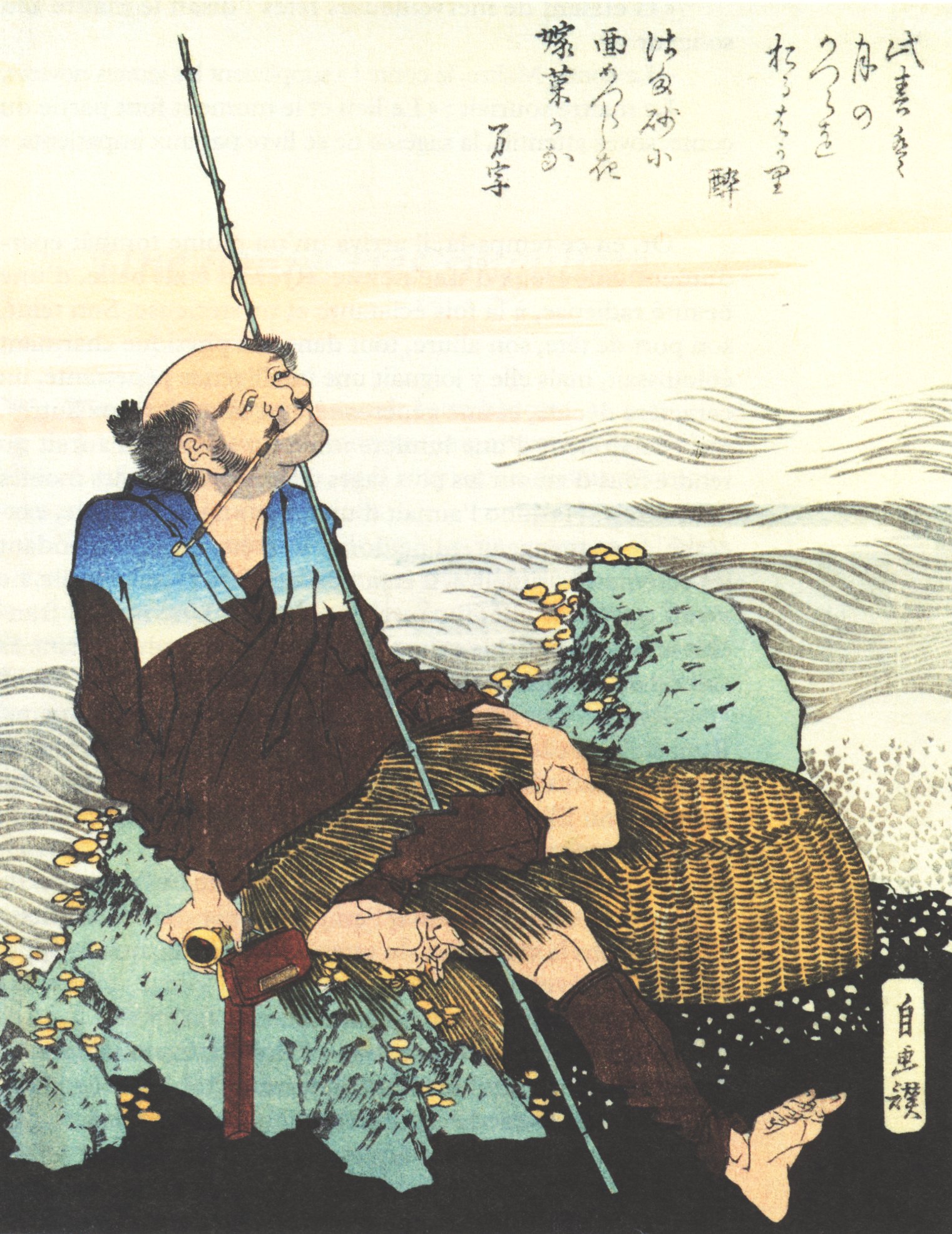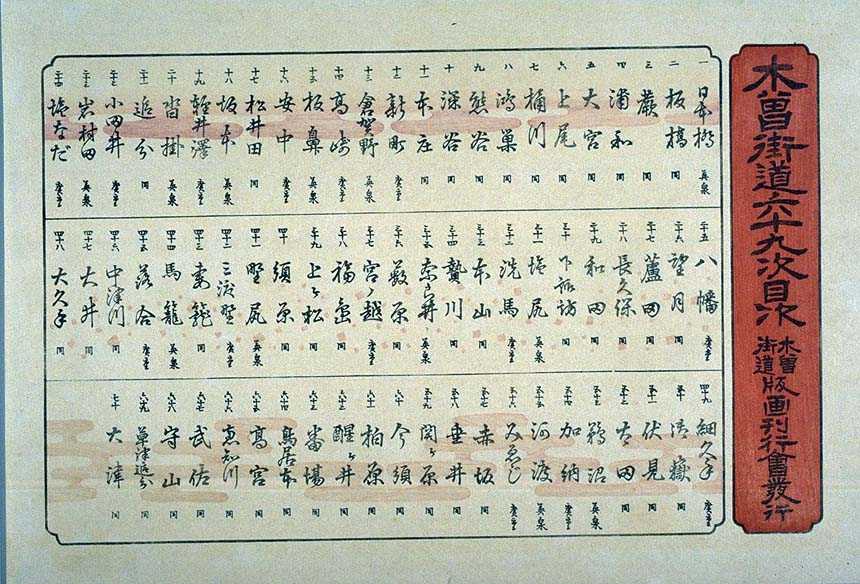|
Keisai Eisen
Keisai Eisen (渓斎 英泉, 1790–1848) was a Japanese ''ukiyo-e'' artist who specialised in ''bijin-ga'' (pictures of beautiful women). His best works, including his ''ōkubi-e'' ("large head pictures"), are considered to be masterpieces of the "decadent" Bunsei Era (1818–1830). He was also known as Ikeda Eisen, and wrote under the name of Ippitsuan. Biography Eisen was born in Edo into the Ikeda family, the son of a noted calligrapher. He was apprenticed to Kanō Hakkeisai, from whom he took the name Keisai, and after the death of his father he studied under Kikugawa Eizan. His initial works reflected the influence of his mentor, but he soon developed his own style. He produced a number of ''surimono'' (prints that were privately issued), erotic prints, and landscapes, including ''The Sixty-nine Stations of the Kiso Kaidō'', which he started and which was completed by Hiroshige. Eisen is most renowned for his ''bijin-ga'' (pictures of beautiful women) which portrayed ... [...More Info...] [...Related Items...] OR: [Wikipedia] [Google] [Baidu] |
Shunga (art)
is a type of Japanese erotic art typically executed as a kind of ukiyo-e, often in woodblock print format. While rare, there are also extant erotic painted handscrolls which predate ukiyo-e. Translated literally, the Japanese word ''shunga'' means ''picture of spring''; "spring" is a common euphemism for sex. Shunga, as a subset of ukiyo-e, was enjoyed by all social groups in the Edo period, despite being out of favor with the shogunate. The ukiyo-e movement sought to idealize contemporary urban living and appeal to the new chōnin class. Shunga followed the aesthetics of everyday life and widely varied in its depictions of sexuality. Most ukiyo-e artists made shunga at some point in their careers. History Shunga was heavily influenced by illustrations in Chinese medicine manuals beginning in the Muromachi era (1336 to 1573). Zhou Fang, a notable Tang-dynasty Chinese painter, is also thought to have been influential. He, like many artists of his time, tended to draw ... [...More Info...] [...Related Items...] OR: [Wikipedia] [Google] [Baidu] |
Surimono
are a genre of Japanese woodblock print. They were privately commissioned for special occasions such as the New Year. Surimono literally means "printed thing". Being produced in small numbers for a mostly educated audience of ''literati'', surimono were often more experimental in subject matter and treatment, and extravagant in printing technique, than commercial prints. They were most popular from the 1790s to the 1830s, and many leading artists produced them. One of the most famous woodblock artists who got his start from producing surimono was Suzuki Harunobu, credited with being the genius behind the later introduction (in the 1760s) of Nishiki-e ("brocade prints"). Use In most cases, surimono were commissioned by poetry societies to illustrate the winning poem in a poetry contest judged by the master of the society. Such prints generally had a small format, often c. 205 × 185 mm, and the relief carving of the Kanji characters took a great deal of technical skill. ... [...More Info...] [...Related Items...] OR: [Wikipedia] [Google] [Baidu] |
1790 Births
Year 179 ( CLXXIX) was a common year starting on Thursday (link will display the full calendar) of the Julian calendar. At the time, it was known as the Year of the Consulship of Aurelius and Veru (or, less frequently, year 932 ''Ab urbe condita''). The denomination 179 for this year has been used since the early medieval period, when the Anno Domini calendar era became the prevalent method in Europe for naming years. Events By place Roman empire * The Roman fort Castra Regina ("fortress by the Regen river") is built at Regensburg, on the right bank of the Danube in Germany. * Roman legionaries of Legio II ''Adiutrix'' engrave on the rock of the Trenčín Castle (Slovakia) the name of the town ''Laugaritio'', marking the northernmost point of Roman presence in that part of Europe. * Marcus Aurelius drives the Marcomanni over the Danube and reinforces the border. To repopulate and rebuild a devastated Pannonia, Rome allows the first German colonists to enter territory ... [...More Info...] [...Related Items...] OR: [Wikipedia] [Google] [Baidu] |
Ukiyo-e Ruiko
Ukiyo-e is a genre of Japanese art which flourished from the 17th through 19th centuries. Its artists produced woodblock prints and paintings of such subjects as female beauties; kabuki actors and sumo wrestlers; scenes from history and folk tales; travel scenes and landscapes; flora and fauna; and erotica. The term translates as "picture of the floating world". In 1603, the city of Edo (Tokyo) became the seat of the ruling Tokugawa shogunate. The '' chōnin'' class (merchants, craftsmen and workers), positioned at the bottom of the social order, benefited the most from the city's rapid economic growth, and began to indulge in and patronise the entertainment of kabuki theatre, geisha, and courtesans of the pleasure districts; the term ("floating world") came to describe this hedonistic lifestyle. Printed or painted ukiyo-e works were popular with the ''chōnin'' class, who had become wealthy enough to afford to decorate their homes with them. The earliest ukiyo-e works ... [...More Info...] [...Related Items...] OR: [Wikipedia] [Google] [Baidu] |
Forty-seven Ronin
47 (forty-seven) is the natural number following 46 and preceding 48. It is a prime number. In mathematics Forty-seven is the fifteenth prime number, a safe prime, the thirteenth supersingular prime, the fourth isolated prime, and the sixth Lucas prime. Forty-seven is a highly cototient number. It is an Eisenstein prime with no imaginary part and real part of the form . It is a Lucas number. It is also a Keith number because its digits appear as successive terms earlier in the series of Lucas numbers: 2, 1, 3, 4, 7, 11, 18, 29, 47, ... It is the number of trees on 9 unlabeled nodes. Forty-seven is a strictly non-palindromic number. Its representation in binary being 101111, 47 is a prime Thabit number, and as such is related to the pair of amicable numbers . In science * 47 is the atomic number of silver. Astronomy * The 47-year cycle of Mars: after 47 years – 22 synodic periods of 780 days each – Mars returns to the same position among the stars and is in the same ... [...More Info...] [...Related Items...] OR: [Wikipedia] [Google] [Baidu] |
Hiroshige
Utagawa Hiroshige (, also ; ja, 歌川 広重 ), born Andō Tokutarō (; 1797 – 12 October 1858), was a Japanese ''ukiyo-e'' artist, considered the last great master of that tradition. Hiroshige is best known for his horizontal-format landscape series '' The Fifty-three Stations of the Tōkaidō'' and for his vertical-format landscape series '' One Hundred Famous Views of Edo''. The subjects of his work were atypical of the ''ukiyo-e'' genre, whose typical focus was on beautiful women, popular actors, and other scenes of the urban pleasure districts of Japan's Edo period (1603–1868). The popular series '' Thirty-six Views of Mount Fuji'' by Hokusai was a strong influence on Hiroshige's choice of subject, though Hiroshige's approach was more poetic and ambient than Hokusai's bolder, more formal prints. Subtle use of color was essential in Hiroshige's prints, often printed with multiple impressions in the same area and with extensive use of '' bokashi'' (color gradation ... [...More Info...] [...Related Items...] OR: [Wikipedia] [Google] [Baidu] |
The Sixty-nine Stations Of The Kiso Kaidō
The or ''Sixty-nine Stations of the Kiso Road'', is a series of ''ukiyo-e'' works created by Utagawa Hiroshige and Keisai Eisen. There are 71 total prints in the series (one for each of the 69 post stations and Nihonbashi; Nakatsugawa-juku has two prints). The common name for the Kiso Kaidō is " Nakasendō" so the series is sometimes referred to as the ''Sixty-nine Stations of the Nakasendō''. It is a follow up to Hiroshige's '' The Fifty-three Stations of the Tōkaidō'' and he produced 47 of the prints, with Eisen being responsible for the rest.Hiroshige - Kisokaido www.hiroshige.org.uk. Accessed November 1, 2017. The series was published by Iseya Rihei (Kinjudō) from .Forrer The ...
|
Kikugawa Eizan
is a city located in the western portion of Shizuoka Prefecture, Japan. , the city had an estimated population of 48,484 in 17,916 households, and a population density of 510 persons per km². The total area of the city is . The city is known for production of green tea. The city's slogan is "Green for the Next Generation". Geography Kikugawa is situated on the Makinohara Plateau of east-central Shizuoka. The Kikugawa River flows through the city. The area enjoys a warm maritime climate with hot, humid summers and mild, cool winters, and is subject to frequent fogs. Surrounding Municipalities Shizuoka Prefecture *Kakegawa *Omaezaki * Shimada *Makinohara Demographics Per Japanese census data, the population of Kikugawa has been relatively steady over the past 30 years. Climate The city has a climate characterized by hot and humid summers, and relatively mild winters (Köppen climate classification ''Cfa''). The average annual temperature in Kikugawa is . The average annu ... [...More Info...] [...Related Items...] OR: [Wikipedia] [Google] [Baidu] |
Japanese People
The are an East Asian ethnic group native to the Japanese archipelago."人類学上は,旧石器時代あるいは縄文時代以来,現在の北海道〜沖縄諸島(南西諸島)に住んだ集団を祖先にもつ人々。" () Japanese people constitute 97.9% of the population of the country of Japan. Worldwide, approximately 129 million people are of Japanese descent; of these, approximately 122.5 million are residents of Japan. People of Japanese ancestry who live outside Japan are referred to as , the Japanese diaspora. Depending on the context, the term may be limited or not to mainland Japanese people, specifically the Yamato (as opposed to Ryukyuan and Ainu people). Japanese people are one of the largest ethnic groups in the world. In recent decades, there has also been an increase in the number of multiracial people with both Japanese and non-Japanese roots, including half Japanese people. History Theories of origins Archaeological evidence ... [...More Info...] [...Related Items...] OR: [Wikipedia] [Google] [Baidu] |
Japanese Calligraphy
also called is a form of calligraphy, or artistic writing, of the Japanese language. Written Japanese was originally based on Chinese characters only, but the advent of the hiragana and katakana Japanese syllabaries resulted in intrinsically Japanese calligraphy styles. Styles The term shodō (書道, "way of writing") is of Chinese origin, and is widely used to describe the art of Chinese calligraphy during the medieval Tang dynasty. Early Japanese calligraphy was originated from Chinese calligraphy. Many of its principles and techniques are very similar, and it recognizes the same basic writing styles: * seal script (篆書 ''tensho'') (pinyin: ''zhuànshū''). The seal script (tensho) was commonly used throughout the Zhou dynasty (1046–256 BC) and the following Qin dynasty (221–206 BC) of China. After this time period, tensho style fell out of popularity in favor of reisho. However, tensho was still used for titles of published works or inscriptions. The ... [...More Info...] [...Related Items...] OR: [Wikipedia] [Google] [Baidu] |




_Awa_Naruto_no_fuukei.jpg)

